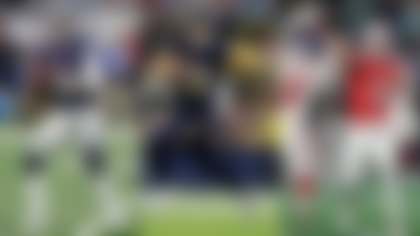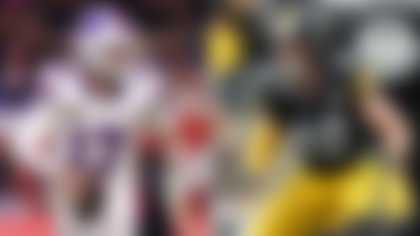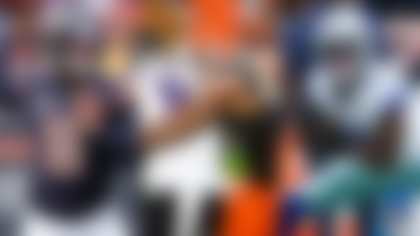Which teams got it right on fourth-down and 2-point conversion calls in Week 9 of the 2021 NFL season -- and which teams got it wrong? The Next Gen Stats analytics team uses the Next Gen Stats Decision Guide powered by AWS to break down the numbers behind the decisions that shaped the game.
Brandon Staley continues aggressive 4th-down approach
Through the first eight weeks of the season, Staley has been featured in our weekly column more times than any other coach (four times; three positive, one negative). We can add another tally to the positive side of the scoreboard following the Chargers’ road win over the Eagles in Week 9, when Staley got all five fourth-down decisions right, according to the NGS Decision Guide.
The Chargers' offense stayed on the field four different times on fourth down -- each with only two or fewer yards to the first-down marker. Three of those situations were strong go-for-it recommendations by our numbers -- by factors of 5.2 percent, 15.3 percent, and 8.8 percent in expected win probability value. The only toss-up decision of the day where Staley kept the offense on the field ...
SECOND QUARTER: With 7:30 remaining and the Chargers (tied at 7-7) facing a fourth-and-2 from the Eagles’ 27-yard line, Joshua Kelly rushes for 1-yard, and the Eagles take over on downs.
The Decision Guide had this decision as a true coin-flip situation, suggesting there was virtually no difference in value between going for it and kicking a field goal (i.e. the difference in win probability of each decision was less than 0.05 percent). The Chargers failed to convert on their second fourth-down try of the game.
Historically, coaches have tended to be more risk-averse than risk-seeking in situations like this; though, in his first year as a head coach -- at any level -- Staley has tended not to lean toward the former. The offense started the season converting on seven of the unit’s first eight fourth-down tries. The unit’s fourth-down luck seemed to run out in recent weeks; the unit failed to convert on five of the next seven tries including this failed attempt against the Eagles.
The string of misses (a small sample size) could have deterred Staley and Co. from going for it in future situations; but that’s not what happened in Philadelphia, as the Chargers successfully converted for a first down on both of their fourth-down attempts on the game’s final drive. According to the NGS model, going for it increased the team’s chances of winning by 15.3 percent and 8.8 percent, respectively.


Cowboys miss on two fourth-down tries, call for suboptimal punt on third
The Cowboys were stunned at home on Sunday against the Broncos, scoring their first points of the game with just 4:14 remaining. If not for two failed fourth-down attempts by Dallas' offense in the first quarter, perhaps the game would have had a different outcome. We are less concerned with the result than with the process in this weekly piece; and in this case, Cowboys coach Mike McCarthy got both decisions correct -- by factors of 2.4 percent and 1.7 percent in expected win probability value. It was the Cowboys’ third fourth-down situation where the numbers and the coach were not in alignment.
FIRST QUARTER: With 3 seconds remaining, the Cowboys (trailing 6-0) elect to punt on fourth-and-1 from their own 45-yard line.
After already failing to convert on two fourth-and-short attempts in the period, McCarthy seemingly threw out his aggressive strategy and punted the ball in this spot. The Cowboys lost 5.1 percentage points of win probability here, more than the combined 4.1 percentage points they gained from their previous two go-for-it decisions of the quarter. Despite a high likelihood of converting (75 percent), McCarthy opted for the more conventional call at this juncture, possibly feeling a drop in confidence from the earlier short-yardage misses.

Urban Meyer inconsistent on fourth down, but Jaguars still stun Bills
The Jaguars pulled off the biggest upset of Week 9 in their narrow win over the Bills. However, Meyer’s mostly conventional approach on fourth down despite being a heavy underdog did the Jaguars no favors. The NGS Decision Guide recommended going for it on five of Jacksonville's nine fourth-down decisions, and yet, Meyer chose to go for it on just one of those five plays. In total, the Jaguars lost a combined 12.1 percentage points in expected win probability over the four plays where Meyer opted to kick a field goal instead of attempt a fourth-down try.
FOURTH QUARTER: With 13:29 remaining, the Jaguars (tied 6-6) elect to go for it on fourth-and-1 from the Bills’ 11 yard-line. Trevor Lawrence dives forward on the quarterback sneak for three yards (taunting penalty on Buffalo’s Levi Wallace results in 4 yards tacked on to the end of the play).
The one time the Jaguars kept the offense on the field was a clear go-for-it situation -- by 7.1 percentage points in win probability value. In this situation, the Jaguars had a 68 percent chance of converting for a first down and a 93 percent chance of making a 28-yard field goal. Lawrence’s successful QB sneak helped propel the Jaguars' win probability from 36 to 50 percent.
FOURTH QUARTER: With 12:13 remaining, the Jaguars (tied 6-6) elect to kick a 21-yard field goal on fourth-and-goal from the Bills’ 3-yard line. Matthew Wright makes the attempt to give the Jaguars a 9-6 lead.
Of the five fourth-down situations where the NGS Decision Guide recommended the Jaguars go for it, the decision to settle for a field goal here was the most impactful from a win probability value lost standpoint. The other three times Meyer opted to kick on fourth down were more of toss-ups -- the Guide found value in going for it but never by more than two percentage points in win probability value. Even though the field goal here ended up being the deciding score, the Jaguars lost a whopping 8.7 percentage points in win probability value by choosing to kick.


Mike Vrabel aligned with analytics in rout of Rams
After establishing an early 14-3 lead off of two turnovers, Vrabel kept the heat on the Rams and went for it on two consecutive series to extend the Titans' drive near the end of the first half and go into halftime with a three-possession lead. These two decisions gained Tennessee a combined 14.3 percentage points in win probability value on a single drive.
SECOND QUARTER: With 4:24 remaining, the Titans (leading 14-3) elect to go for it on fourth-and-1 from the Rams’ 9-yard line. Ryan Tannehill converts on the quarterback sneak for two yards.
The NGS Decision Guide had a very strong recommendation to go for it in this situation (10.4 percentage points of win probability value). From the ball-tracking data, we know the Titans only had half a yard in actual yards to go. Given this especially short distance, the Titans had an 81 percent chance of moving the chains and converting the first down and, by doing so, increased their win probability 4 points to 66 percent. Attempting the field goal had a higher likelihood of success (94 percent), but extending an 11-point lead into a 14-point lead -- instead of pushing for another touchdown -- would have actually dropped the Titans' win probability from 62 percent to 54 percent.
SECOND QUARTER: With 2:15 remaining, the Titans (leading 14-3) elect to go for it on fourth-and-goal from the Rams’ 1-yard line. Ryan Tannehill scores a touchdown on a naked bootleg run.
The Titans' drive stalled again, this time at the goal line, but Vrabel wasn’t going to settle for a field goal after already extending the drive on the previous series. Once again the NGS Decision Guide favored going for it, this time by 3.9 percentage points. The Rams had a 74 percent chance of converting the fourth down try, and Tannehill had an easy path to score the TD off of a play action naked bootleg that fooled the Rams' defense.
Follow the Next Gen Stats team on Twitter.















